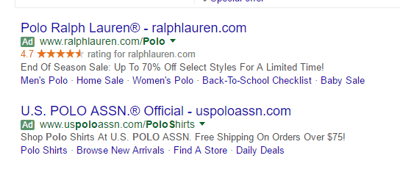Dynamic Search Ads (DSA) are meant to solve a fundamental issue with search marketing; how to connect a business’ site with relevant search queries. So what are DSAs anyway?
Upon first glance a Dynamic Search Ad looks like your typical Google AdWords ad. There’s a headline, text, link, etc. The difference between your normal Google AdWord creation and a DSA is that Google is in the driver’s seat with your ads, not the digital agency that normally would create your ads. Google will crawl through your website pages to create ads for users relevant to their searches. Google will search for the most relevant copy on your site and will create custom landing pages and headings for each search query.
For instance, if you search for “polos” on Google, you will see a few ads at the top of the search  results that appear to not have been written by an advertiser. Each of these results includes a custom header, copy underneath and a landing page. That landing page will redirect you to all the polos on the website, eliminating the need to go to the website first and then do a search on that website for the item.
results that appear to not have been written by an advertiser. Each of these results includes a custom header, copy underneath and a landing page. That landing page will redirect you to all the polos on the website, eliminating the need to go to the website first and then do a search on that website for the item.
The headline and landing page are dynamically generated by Google utilizing the user’s exact language to give them exact matches. This method is incredibly efficient. By implementing DSAs your business can connect with qualified prospects much quicker, reduce the amount of time spent adjusting campaigns and expanding your coverage.
How do you set up the DSA
There are several techniques supported by Google to create a DSA campaign.
Consider targeting ads based on user behavior which can be broken down into five categories.
1. Use categories as your dynmaic ad targets
Categories are customized and created by Google based on your site and offerings. For instance, let’s say your business is in electronics and you would like to focus on digital cameras. The DSA will create categories that are custom but user friendly to your product.
2. Select a DSA based on the language of users
Language targeting should match both your website copy and the way in which you think users are searching.
3. Select all-website targeting
It is possible to target only a few pages of your website. However, your ad can be more effective if you select the option of allowing Google to crawl through your entire site and make the selection for you.
4. Separate high volume dynamic ad targets based on Insights
Insights are reports generated by Google, Facebook, Twitter, etc., that offer an understanding of user behavior. Each “Insights Report” will differ in information provided based on the channel and channel specific goals. With Google, you can see how each user came to your site, how long they stayed on your site and what path they took once reaching your site. Take a look at your insights to determine where the best categories are and adjust your marketing strategy from there.
5. Create different Ad Groups
An ad group contains one or more ads that share a targeted set of keywords. Be sure to do some testing as you would with any other ad campaign. Determine where your marketing dollars are best being spent.
Dynamic Search Ad performance can be optimized through the use of negative keywords. A negative keyword is a keyword you do not want your brand to be associated with. Whenever someone searches for those terms, your ad will not be triggered. Negative keywords are a great way to ensure you are getting quality traffic to your site.
A combination of tactics is also a great way to get DSA to work for you more efficiently. By utilizing AdWords Automated Bidding tool, you can use tools like auction time signals to create more efficient and cost-effective ads.
Now that we know what a DSA is and how to create them, what are the search marketing benefits of this system?
 According to LunaMetrics, there are 1 billion searches on Google daily. 20% of those searches are completely unique, meaning Google has never seen those search terms before. It would be impossible for a marketing agency or business to keep up with the daily trends in Google searches. That’s where DSA comes in. It is likely that some of those searches will be related to your business but maybe your business did not list all of the possible associated keywords. How could you when it changes in real time? Google’s DSA algorithm is going to interpret the content of your website and how it relates to users search query by dynamically creating custom headlines and landing pages.
According to LunaMetrics, there are 1 billion searches on Google daily. 20% of those searches are completely unique, meaning Google has never seen those search terms before. It would be impossible for a marketing agency or business to keep up with the daily trends in Google searches. That’s where DSA comes in. It is likely that some of those searches will be related to your business but maybe your business did not list all of the possible associated keywords. How could you when it changes in real time? Google’s DSA algorithm is going to interpret the content of your website and how it relates to users search query by dynamically creating custom headlines and landing pages.
This method is more time efficient than self-managing your Google AdWord campaign by releasing some control to Google.
The simplest benefit? The maximum amount of exposure that comes from a DSA. With a DSA, you have the power to tell Google that every page is vital to your business and Google will deliver ads to those pages whenever a search matches your content.
What to consider before creating a DSA
One key factor is that your on-page Search Engine Optimization (SEO) needs to be flawless. If the content on your website is not Search Engine Optimized you’re going to have a much harder time getting Google’s search algorithm to include it in a DSA search result and getting your website in front of users.
Not every business is a good fit for the DSA either. Pages with limited services or products, daily deals or revolving products will not see any real benefit from the DSA because there is not enough information to generate unique landing pages based on users search queries.
The biggest challenge is turning your marketing over to Google. Marketers tend to be invested in the outcomes of their advertisements; therefore turning it over to Google can lead to unpredictable results. One way to combat this issue is by checking on the ad campaign frequently and making adjustments as needed. You can add negative keywords, add or delete pages from your DSA, change categories, etc.
The easiest way to know if a DSA is right for you is by simply testing it out. Set a goal for the DSA, a budget and a timeline (I recommend at least three months) and see how well they work for you and your business.
The Dynamic Search Ad also costs less per click than traditional Google AdWord campaign because the DSA only shows to relevant audiences. These ads use the internet user’s exact language in the header and text. The DSA also provides a custom landing page based on what the prospect is searching for. Instead of vaguely matching a user’s inquiry, your business can match prospects needs exactly.
Before your DSA can be successful, your website's on-page SEO needs to be flawless. Are you sure it's perfect? Find out with a free analysis!


_(1).png?width=190&height=84&name=TMD_LOGO_338x149_(web)_(1).png) The Marketing Department Malvern, PA is a full service Marketing Agency serving Malvern, Main Line, King of Prussia, Wayne, Paoli, Berwyn, Chester County and Montgomery County, PA areas.
The Marketing Department Malvern, PA is a full service Marketing Agency serving Malvern, Main Line, King of Prussia, Wayne, Paoli, Berwyn, Chester County and Montgomery County, PA areas.